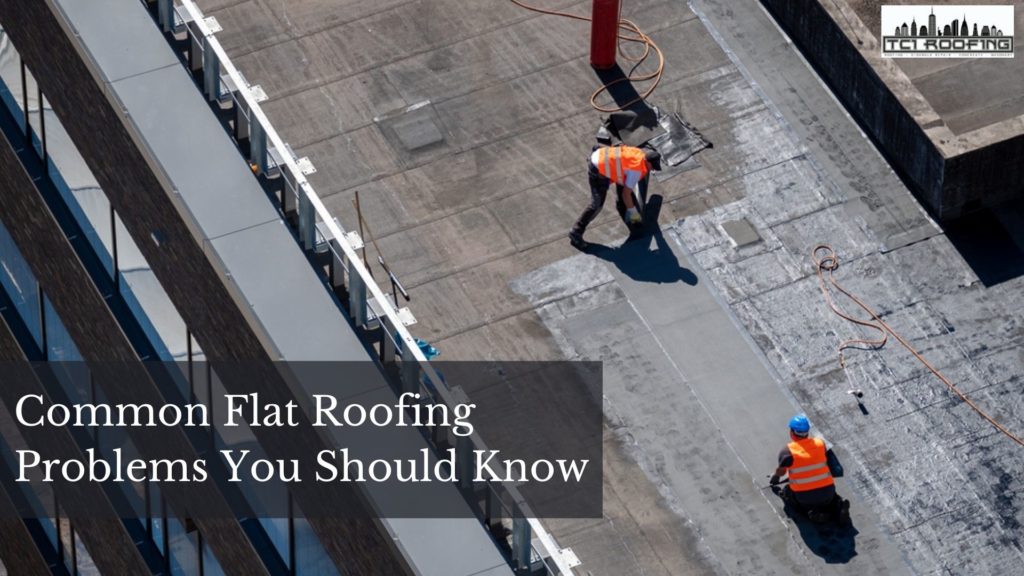Flat roofs have been popular for a long time, and it is no surprise why. They are a versatile design that can be used to cover many different types of structures. Flat roofing systems protect against harsh weather conditions while also being more affordable than sloped roofs in most cases. However, flat roofing does come with its own set of challenges and problems, which you should know about if you want to use this type of roof system on your home or business building. In the following article, we will discuss some common flat roofing problems so that you can determine what type of system would work best for your needs!
8 Common Flat Roofing Problems
Finding the exact spot or source of any flat roofing problem that may arise is a challenge with flat roofs. Things aren’t always as they seem when it comes to flat roofs. Because water can linger between layers of roof materials for a long time before entering the house, the visible location on the outside may be far from the point where the leak becomes noticeable inside.
It’s a good idea to spend on roofing inspection and maintenance because you never know when you’ll have a roof problem. As a homeowner or property manager, you may run into some of the following frequent flat roofing issues if it doesn’t have regular maintenance.
Openness
All flat roof common problems start with a lack of transparency. Damage is unavoidable because your roof is continually exposed to the sun and other elements. And no matter how robust your roofing material is, the weaker it will get, the longer it is exposed to these factors.
Lightning strikes, frost, hail, and wind damage are all problems connected with open flat roofs. There are a few unusual openness difficulties as well. Contact a professional Manhattan roofing contractor that will be able to complete the job!
Ponding
Ponding is the term for having a water pool on your roof. If this pool is left unattended for a long time, it will seek ways to breach your roof, resulting in roof leaks.
When it rains or snows, the precipitation has nowhere to go because your roof is flat. However, the roof on your home will shift over time as it settles, so it may not be as level as it was when it was erected. Water may collect in divots and dips on your roof as a result of this.
Although most materials are designed to withstand water, you should drain these pools as quickly as possible and check whether water has seeped into the roof’s bottom layers. If ponding is allowed to persist, the exterior of your roof will erode, reducing the flat roof’s lifespan. So, make sure to have it check as soon as possible with a reliable roofing contractor like TCI Manhattan Roofing Repair Services. We offer the best roofing repair services in Manhattan NYC, contact us today!
Watermarks
It will leave watermarks on your roof after a long period of ponding, allowing water to pass through on the next attempt. You might not notice watermarks at first glance, but they can be a major problem. In addition, if your roof has been compromised and rainwater seeps through to the ceiling below from where it is collecting on flat roofs, you will have an even bigger issue than ponding alone.
Vegetation
Water development is indicated by the presence of greenery, parasites, lichen, and weeds. Flat roofs are perfect for growing vegetation, but this can be a serious problem. Flat roofing materials were not designed to have the ability to endure constant contact with soil and other elements. There is also an increased chance of leakage because water will always seek out the easiest path into your home or business building’s interior.
Weeds are common in flat roofs as they can endure the lack of nutrients in such a dry environment. However, their presence is still undesirable because they will eventually crack your roofing material if left to grow unchecked.
Breaking Or Extending At Joints Or Corners
Due to drying out or extending, the flexible materials that make up the waterproof layers of your roof can crack or rip with age. This is typical of EPDM or elastic roofing (Ethylene-Propylene-Diene-Monomer).
Bleb
You’ll see a bubble on your roof’s surface at this point. It may erupt one day, allowing water to enter your home directly. On flat roofs, bleb and other surface abnormalities, such as “alligatoring,” are common. A flat roof layer that has decomposed like croc skin is known as alligatoring. The majority of surface flaws are caused by excessive sun exposure or immersed protection.
Rusted Or Missing Roof Nails
As bare nails rust or fall out on older homes, your roof might become a water entry site. Flat roofs are more susceptible to problems because they’re made of several layers. Only a few nails may be visible from the outside, but there is usually an interior row as well. The weight of the water can push up those lower levels and penetrate your roof’s waterproofing layer.
Holes
Common flat roofs often have holes in them. Flat roofs lose their ability to shed water when this happens, especially if they are not well maintained. When dampness is unable to absorb moisture from the roof, it will find and enter the structure.
Flat roof holes may appear to be innocuous, but if not addressed and repaired promptly, they can cause serious problems with flat roofs.

